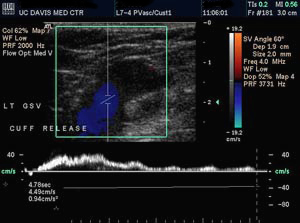Venous insufficiency (varicose veins / insufficiency)

Doppler evaluation showing retrograde (reversed) venous flow
In the lower extremities, blood returns to the heart through a network of deep and superficial veins. Normal venous flow patterns depend on open venous channels and the function of numerous valves within the veins. Venous insufficiency may occur if veins are obstructed (from chronic thrombus, for example) or if the valves are incompetent — no longer providing for only one-way flow. Venous valvular incompetence in superficial veins or the communicating veins that connect the deep and superficial veins can result in varicose veins. Untreated chronic venous insufficiency in the deep or superficial venous system can cause a progressive syndrome involving pain, swelling, skin changes and eventual tissue breakdown.
Duplex scanning of the deep and superficial veins can detect obstruction. In addition, the function of valves in each segment of the evaluated veins can be assessed by determining the direction of blood-flow using Doppler ultrasound. The examination is often done in the upright position, as this is the best way to evaluate valve function.
Evaluation of the function of the lower extremity veins is not needed in every case, but when surgical treatment, sclerotherapy,or saphenous venous ablation (Closure) is being considered, a complete lower-extremity venous duplex scan can provide valuable information that may guide therapy. A complete study may include both lower extremities.
No special preparation is required. A complete study usually takes about 30 to 60 minutes.
Treatment of venous insufficiency always includes the three "E's:" elevation of the leg, exercise and use of elastic compression. In cases where an intervention or surgery are considered, the duplex scan can provide essential information about which vein segments are abnormal, whether obstruction or reflux are present (or both), and how extensive a problem exists. This information will guide the vascular specialist's recommendations and provide information that may help predict how successful treatment might be.
